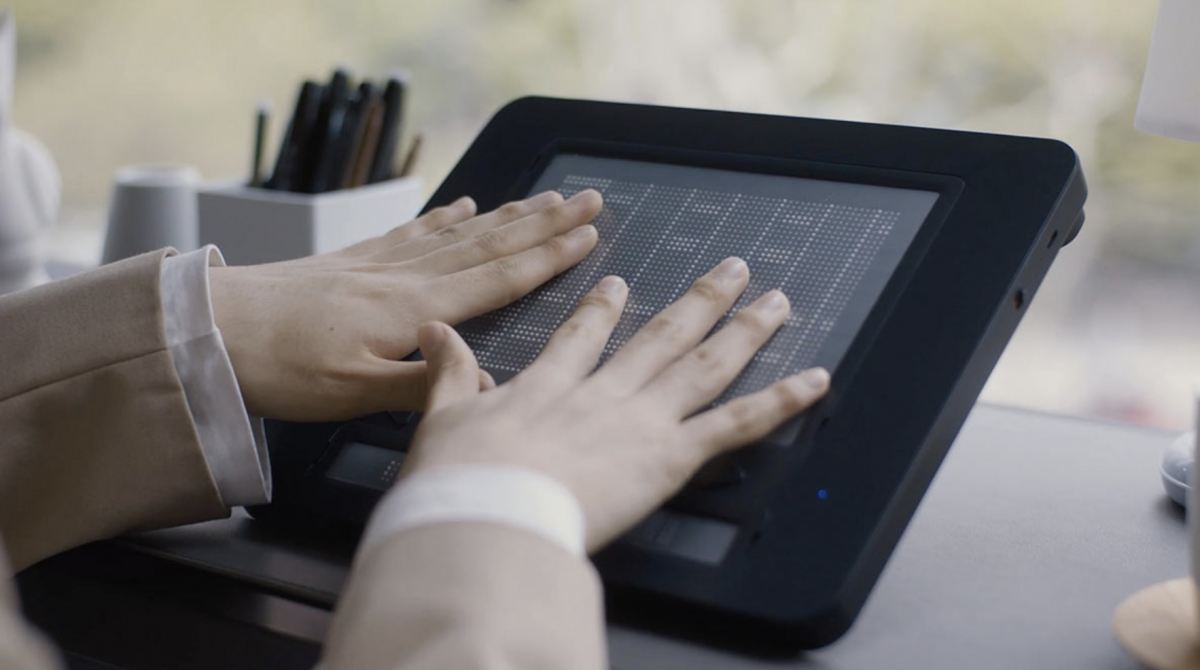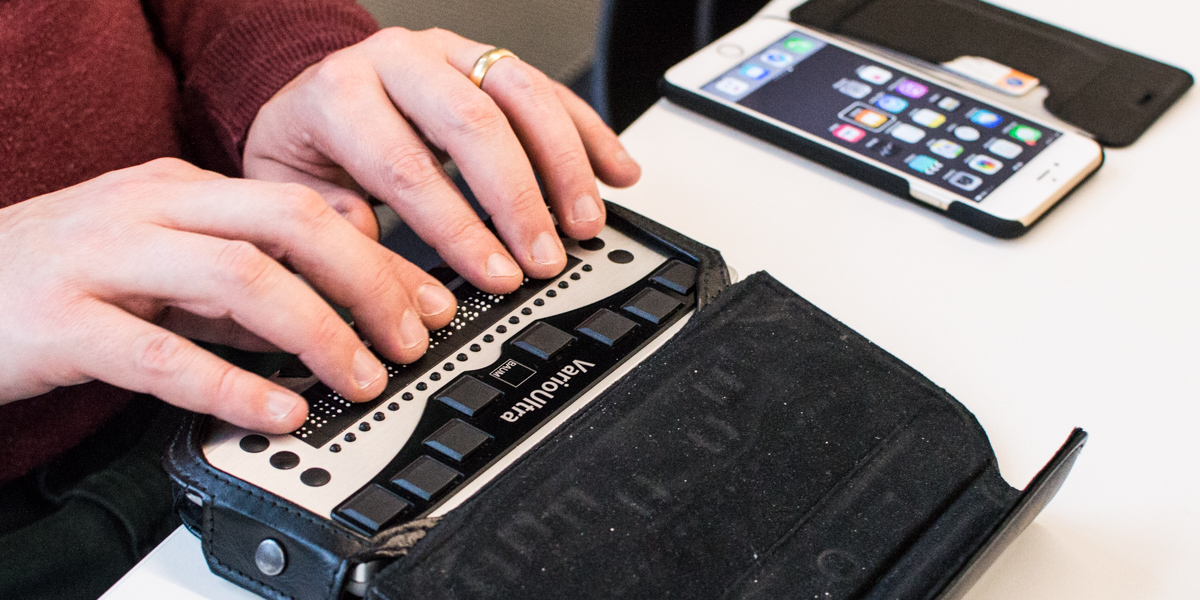Voice-Activated Assistive Devices: Enabling the Visually Impaired
Voice-Activated Assistive Devices: Enabling the Visually Impaired
Blog Article
Discover Cutting-edge Tools Developed for the Aesthetically Damaged
The advancement of innovative tools for the aesthetically damaged stands for a significant improvement in accessibility and independence. Technologies such as clever glasses with AI abilities and mobile applications made to supply acoustic summaries are improving everyday experiences for individuals. Furthermore, wearable gadgets that employ haptic feedback boost environmental recognition, while modern-day Braille innovations use new methods to involve with text. As these devices remain to evolve, their effect on the lives of those with aesthetic problems elevates important inquiries about the future of inclusivity and freedom in different aspects of life. What lies in advance in this technical landscape?
Smart Glasses for Navigating

Smart glasses designed for navigating are transforming the method aesthetically damaged individuals engage with their environment. These innovative gadgets use a combination of video camera technology, man-made knowledge, and acoustic feedback to supply real-time info about surroundings. By utilizing challenge discovery systems, wise glasses can alert users to prospective hazards, making it possible for more secure mobility in both familiar and unfamiliar setups.
The combination of GPS modern technology further enhances navigation capacities, permitting users to receive acoustic directions as they move. This hands-free strategy not only promotes freedom however likewise encourages visually impaired people to browse metropolitan landscapes with boosted self-confidence. Additionally, numerous clever glasses are outfitted with attributes that recognize landmarks and road indications, giving contextual details that improves the user experience.
Additionally, the advancement of these tools is constantly progressing, with firms functioning to boost the accuracy of things acknowledgment and broaden the variety of navigational functions. As wise glasses become a lot more easily accessible and affordable, they hold the potential to dramatically change life for visually impaired individuals. Inevitably, these ingenious tools represent an essential step toward inclusivity, offering boosted wheelchair and a higher sense of freedom for individuals navigating the globe around them.

Mobile Application for Daily Living
Exactly how can mobile applications improve the day-to-days live of aesthetically impaired people? Mobile apps are revolutionizing the means visually damaged users navigate their settings, take care of daily jobs, and access information. These applications provide essential assistance with various functionalities, promoting independence and enhancing quality of life.
A number of cutting-edge mobile applications are made especially for daily living. Apps like Be My Eyes attach visually impaired individuals with sighted volunteers by means of video clip calls, allowing them to get real-time support with tasks such as reviewing tags or navigating strange rooms. Similarly, Seeing AI, created by Microsoft, makes use of fabricated knowledge to describe environments, checked out message, and identify things, effectively transforming a smartphone right into a powerful device for day-to-day aid.
Additionally, navigation apps tailored for the visually impaired, such as Aira and BlindSquare, provide audio-based directions and ecological information, making it possible for users to traverse their environments securely and confidently. Past navigating and immediate support, mobile apps also sustain organization and task administration, with features that assist individuals set pointers, develop order of business, and track consultations. In summary, mobile applications act as essential sources, equipping aesthetically damaged people to lead more independent and satisfying lives.
Wearable Technologies for Assistance
Empowerment via innovation is significantly obvious in the world of wearable devices developed to assist visually damaged individuals. These ingenious tools incorporate flawlessly right into day-to-day live, improving navigation and giving important responses to individuals. For example, smart glasses outfitted with video cameras can identify faces and read text out loud, permitting users to communicate even more with confidence in specialist and social setups.
An additional notable innovation is making use of haptic comments systems in wearable tools. These systems make use of vibrations or other responsive signals to convey details concerning the individual's environment, such as barriers or adjustments in surface, enhancing wheelchair and safety and security. Wearable modern technologies also consist of wristbands that attach to mobile phones, signaling users to notifications through refined vibrations, thus enhancing connection without dependence on visual cues.
As these innovations remain to evolve, they are website here not only boosting self-reliance for aesthetically impaired people but additionally cultivating a greater feeling of inclusion in culture. By bridging the void between challenges dealt with in day-to-day living and the possibility for autonomy, wearable innovations act as crucial devices in the pursuit for equality and empowerment for those with aesthetic disabilities.
Audio Description Devices
Audio description tools play an important function in improving availability for aesthetically impaired individuals, supplying them with the capacity to engage with visual media. Braille displays and notetakers. These tools offer narrated summaries of key aesthetic components in films, tv programs, and live efficiencies, ensuring that individuals can completely comprehend the context and feelings communicated through visuals
Audio summary can be incorporated into different systems, consisting of streaming solutions, movie theater screenings, and live movie theater. Several popular streaming services now consist of audio summary as an accessibility attribute, permitting audiences to pick it quickly. Along with conventional media, specialized apps likewise exist, supplying audio descriptions for art exhibits, museums, and other social events.
The effectiveness of audio description rests on the skill of the storytellers, that have to share visual details succinctly without detracting from the initial sound. Advancements in this field are also leading the means for even more individualized experiences, where users can readjust the level of detail and pacing according to their choices.
Braille Innovations and Gadgets
Braille tools and advancements have considerably transformed the way visually damaged individuals engage with message and details. Modern developments have resulted in the development of functional tools that boost literacy and independence among individuals. Especially, Braille show innovations have actually progressed, allowing for dynamic reading experiences. These tools convert digital message right into Braille, allowing individuals to access a huge range of info on mobile phones, computer systems, and tablet computers.
Furthermore, portable Braille notetakers integrate traditional Braille input with modern-day performances, facilitating note-taking, scheduling, and file editing and enhancing on the move. Assistive technology for the blind. These compact devices commonly feature text-to-speech capabilities, connecting the space in between Braille and acoustic info
Additionally, innovative Braille printers have actually emerged, allowing customers to produce Braille labels, documents, and instructional materials efficiently. This accessibility promotes higher participation in professional and academic settings, eventually advertising inclusivity.
In addition, research into wise Braille innovations remains to increase. Gadgets that integrate expert system are being discovered to supply real-time navigating assistance and contextual information, improving the customer experience in diverse setups. On the whole, these technologies reflect a commitment to equipping visually impaired people with modern technology, guaranteeing they can quickly gain access to and engage with the world around them.

Verdict
The development of ingenious devices for the aesthetically impaired significantly improves independence and high quality of life. These modern technologies not only foster better inclusion yet likewise promote freedom in daily activities, eventually contributing to an extra equitable and available society for aesthetically damaged people.
As clever glasses become extra accessible and budget friendly, they hold the potential to a fantastic read substantially change everyday life for aesthetically damaged users. Mobile applications are transforming the method visually damaged customers navigate their atmospheres, manage everyday tasks, and accessibility info. Apps like Be My Eyes connect aesthetically damaged users with sighted volunteers using video clip telephone calls, allowing them to get real-time help with tasks such as reading labels or browsing strange areas.In addition, navigating apps customized for the visually impaired, such as Aira and BlindSquare, supply audio-based directions and environmental information, allowing customers to traverse their surroundings securely and with confidence.The improvement page of cutting-edge devices for the visually impaired dramatically enhances self-reliance and quality of life.
Report this page